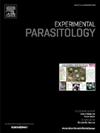Development of a multiplex PCR assay targeting mitochondrial cytochrome oxidase subunit III (cox3) gene for simultaneous specific and sensitive detection of Babesia gibsoni and Babesia vogeli in dogs
IF 1.6
4区 医学
Q3 PARASITOLOGY
引用次数: 0
Abstract
Canine babesiosis is a potential threat for the dog population worldwide. Rapid, sensitive, and specific identification of the etiological agent to the species is pivotal for initiating effective therapeutic and control measures. Co-infection with multiple species pathogens due to multiple vectors infesting dogs is not uncommon. A multiplex PCR (Bg-Bv mPCR) for simultaneous detection and differentiation of the two common Babesia species, B. gibsoni and B. vogeli has been developed targeting the mitochondrial cytochrome oxidase subunit III (cox3) gene. These two species are the species responsible for causing canine babesiosis in Indian subcontinent and Southern Asia. This cox3 gene is present in high copy number and the sequences are species specific and hence targeted to develop the diagnostic multiplex PCR. The multiplex PCR was able to detect up to 5 pg DNA of the Babesia species. No cross-amplifications were observed between the primers specific for either B. vogeli or B. gibsoni. The Bg-Bv mPCR resulted in significantly higher B. gibsoni positives (30/250) than existing 18S ribosomal RNA PCR (22/250). Similarly, the mPCR detected more B. vogeli (26/250) than the 18S rRNA PCR (18/250). The kappa statistics when applied to the results generated by each of the PCR tests also revealed a substantial to perfect agreement between the data. The multiplex PCR targeting cox3 gene is thus a rapid, sensitive, and specific method for simultaneous detection and differentiation of the B. gibsoni and B. vogeli.

建立一种针对线粒体细胞色素氧化酶亚基III (cox3)基因的多重PCR检测方法,用于同时特异性和敏感性检测犬巴贝斯虫和沃氏巴贝斯虫。
犬巴贝斯虫病是全球犬类的潜在威胁。快速、敏感和特异的病原体鉴定对于启动有效的治疗和控制措施至关重要。由于多种病媒感染狗而导致多种病原体的共同感染并不罕见。建立了一种针对线粒体细胞色素氧化酶亚基III (cox3)基因的多重PCR (Bg-Bv mPCR)方法,用于同时检测和区分两种常见的巴贝虫,gibsoni和B. vogeli。这两个物种是导致印度次大陆和南亚犬巴贝斯虫病的物种。该cox3基因存在高拷贝数,序列具有物种特异性,因此有针对性地开发诊断多重PCR。多重PCR能够检测到巴贝虫物种的DNA高达5 pg。未观察到沃氏勃氏杆菌和吉布斯勃氏杆菌特异性引物之间的交叉扩增。与现有的18S核糖体RNA PCR(22/250)相比,Bg-Bv PCR的gibsoni阳性结果(30/250)显著提高。同样,mPCR比18S rRNA PCR(18/250)检测到更多的B. vogeli(26/250)。kappa统计数据应用于每个PCR测试产生的结果时,也揭示了数据之间的实质性到完美的一致性。因此,针对cox3基因的多重PCR是一种快速、灵敏、特异的同时检测和分化gibsoni B.和vogeli B.的方法。
本文章由计算机程序翻译,如有差异,请以英文原文为准。
求助全文
约1分钟内获得全文
求助全文
来源期刊

Experimental parasitology
医学-寄生虫学
CiteScore
3.10
自引率
4.80%
发文量
160
审稿时长
3 months
期刊介绍:
Experimental Parasitology emphasizes modern approaches to parasitology, including molecular biology and immunology. The journal features original research papers on the physiological, metabolic, immunologic, biochemical, nutritional, and chemotherapeutic aspects of parasites and host-parasite relationships.
 求助内容:
求助内容: 应助结果提醒方式:
应助结果提醒方式:


